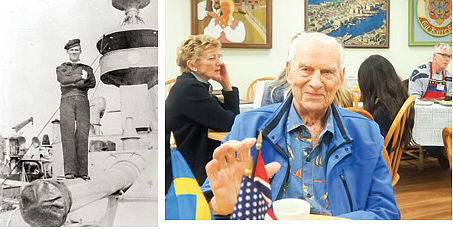Don't Mess with Knut
May 30, 2016 at 10:21 a.m.
101-year old Knut Einarsen is an active member of the community. His sharp wit and infectious smile draw delighted people into conversation with him wherever he goes.
“Don’t mess with Knut Einarsen” was the first sentence in Knut’s biography published in 2000. Born in northern Norway at the onset of WWI, Knut is the product of a rugged, land-of-the-midnight-sun upbringing.
In 2015, Knut, who had been employed for 34 years as a commercial halibut fisherman, was presented to Norway’s King Harald V at the Pacific Fishermen’s Shipyard in Seattle along with other fishermen and women of the Pacific Northwest.
Wrestling with and cleaning massive halibut during 20-hour work-days was a fraught-filled occupation, but it had provided a good living for the former refugee – someone who had escaped on foot to Sweden during a blustery winter month. Knut was a formidable foe against the German Nazis who attacked and occupied the country of his birth. He was the youngest of seven brothers, all of whom participated in the dangerous Resistance efforts. His older brother, Marellius, was killed while assisting British allies in northern Norway during the first few weeks of the attack.
When Hitler’s forces invaded Norway’s main seaports in 1940, Knut’s family owned a freighter called the Vandringen (the Wanderer). In early 1943, Knut was informed by Nazi officials that they would confiscate the well-built, 67-foot Vandringen. Knut, however, remembered his brother, Marellius, who had died in his arms after being shot by the Germans – and he lied to the Nazis about its condition.
“The bow is full of dry rot,” he said, fearlessly matching their hardened, hawk-like eyes with his own stony expression. A shipyard supervisor in Narvik, a friend of the Einarsen family, filed a false report stating that the Vandringen was in need of repair. Just a few days later, however, on a snowy Saturday in March, an officer telephoned Knut and ordered him to report to Nazi headquarters. Someone sympathetic to the Germans had betrayed him.
Knut, who was assisting his mother in another town at the time, called to warn his wife, Haldis. “I’m going to pick you up; have your skis with you,” was his terse message. A few hours later, Knut piloted Vandringen to Skarstad where he was shocked to learn that a man from the Norwegian underground who was to guide them into Sweden had been arrested. Fortuitously, Knut’s cousin, the captain of a freighter, happened to be in Skarstad and agreed to help them. Twenty-four people, including the Einarsens were soon hidden on board. During the wee hours of that Sunday morning, the brave pilot navigated without lights through the long, hazardous Tysfjord, skillfully avoiding the Nazi patrols. Six hours later the fugitives were dropped off on the shore of a steep mountain.
Wearing white sheets for camouflage over their woolen clothes, they carved icy steps on the side of the treacherous mountain, carrying skis, clothing, food, rifles and rounds of ammunition. Four hours later they reached the summit. Two or three times they had to throw themselves face down on the frozen tundra when German surveillance planes flew close by.
They then skied and walked for the next 36 hours. Everything but their skis and the clothes on their backs were discarded as the exhausting journey began to take its toll. Haldis sat down on the hard snow and refused to continue, “We have to go over the next hill, then we are there,” coaxed Knut again and again.
The group knew they were in Swedish territory when they discovered an indigenous teepee-shaped grass hut beyond one of the hills; it had a stove and a supply of dry wood. They were able to rest for the first time in two days. The next morning they set off again and eventually found help—and were assured of safety—at a power station outpost.
Knut and Haldis remained in Sweden until the end of WWII. During this time, Knut made numerous clandestine trips back to his homeland to serve as a guide to other Norwegians fleeing the brutal Nazi occupiers. In 1948, Knut and Haldis emigrated to the U.S. with their one-year-old son, Kent.
Knut is a 51-year member of the Leif Erikson Lodge in Seattle. He and his wife Haldis spent countless hours as volunteers working in the bustling kaffestua (coffee house), and Knut donated almost 1,000 hours as a laborer when the charming three-story Scandinavian chalet-style building was being constructed in the mid-1980s. In 2011, the couple celebrated their 71st wedding anniversary. Haldis passed away at the age of 90 in March 2013.
On February 10, 2016, Knut was awarded the Norwegian Government’s commemorative Defense Medal (Deltagermedaljen), which reads: “The Government of Norway wishes to thank you, Knut Einarsen, for your valuable service in helping to restore freedom to our land.”





